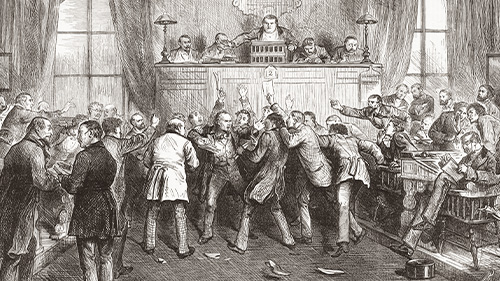AP® Macro: Tying it All Together
Over the years I’ve come to realize that, like any other subject, Macroeconomics is best retained when connections are made. It is for this reason...
AP & Honors Mathematics
Explore Wiley titles to support both AP and Honors mathematics instruction.
Literacy Skills & Intensive Reading
Connections: Reading – Grades 6–12
Empower student success with a proven intensive reading program that develops strong reading skills in striving readers.
Drama, Speech & Debate
Basic Drama Projects 10th Edition
Build students’ confidence and competence with comprehensive, project-based theatre instruction.
Literature
Connections: Literature
Support learners as they study dynamic, relevant texts and bring the richness of diverse voices to students through literature.
Literature & Thought
Develop critical thinking, reading, and writing across literacy themes, genres, historical eras, and current events.
Language Arts
Vocabu-Lit® – Grades 6–12
Help students build word power using high-quality contemporary and classic literature, nonfiction, essays, and more.
Connections: Writing & Language
Help students develop grammar, usage, mechanics, vocabulary, spelling, and writing and editing skills.
Reading/English Language Arts
Measuring Up to the English Language Arts Standards
Incorporate standards-driven teaching strategies to complement your ELA curriculum.
English Language Learners
Measuring Up for English Language Learners
Incorporate research-based best practices for ELLs with an approach that includes a focus on language acquisition strategies.
Mathematics
Measuring Up to the Mathematics Standards
Incorporate standards-driven teaching strategies to complement your mathematics curriculum.
Foundations
Measuring Up Foundations
Help students master foundational math skills that are critical for students to find academic success.
Science
Measuring Up to the Next Generation Science Standards
Give students comprehensive NGSS coverage while targeting instruction and providing rigorous standards practice.
Assessment
Measuring Up Live
Deliver innovative assessment and practice technology designed to offer data-driven instructional support.
For a better website experience, please confirm you are in:

Let’s face it, poorly answered free response questions are hard on both teachers and students. Most students shudder at the thought of answering the free response questions in AP Macro because it requires them to gather all their knowledge AND apply it. When teachers see poorly answered FRQs, we typically ask ourselves where we went wrong.
I will give them the “FRQ Rules of the Road” talk the first few times we work in groups to practice. These guidelines might seem like common sense, but you shouldn’t assume students automatically understand them. Remind students of these rules each time FRQs are practiced, allowing them to focus more on the content that needs to be answered.
Here they are, in no particular order.
The FRQs in AP Macroeconomics are a little challenging for students at the outset. The first time we work on an FRQ I usually give them a short, 5 question FRQ, typically, something having to do with opportunity cost and terms of trade. When we do work on the first 2 or 3 free response questions, I try to make it less intimidating by putting the students in pairs or triads. This usually takes the pressure off and lets them dig in knowing that they can rely on each other. I don’t typically grade the first one or 2 FRQs that they do in groups unless it is for a “practice grade” where they know they must be engaged to receive a participation grade. As we move further into the course, I may pair them up using a more difficult FRQ for a grade but typically, this group scenario allows for less tension at the beginning.
Taking the time to review the rules of the road for FRQ answering seems to help in a few areas. First, putting the rules out there removes the mundane remediation requirement of repeating these things and allows you, the teacher, to focus on content. Second, they create habitual behavior and a “practice like you play” mindset. Lastly, once these habits are put into place, students tend to feel more secure as they know what is expected from them every time. Do you have any “rules of the road” that you use? Drop them in the comment section below! I’d love to hear them!

Over the years I’ve come to realize that, like any other subject, Macroeconomics is best retained when connections are made. It is for this reason...

There is less than a month until the AP® Econ exams. It is crunch time for students—especially those taking multiple AP®exams. These exams can be a...

So, it’s almost time for the AP Economics exams. Hopefully, you have started a countdown. If not, that is step one. You want to remind students (so...

You know the Style #4 Free Response Question on the College Board’s national Government exam can be a real challenge. I am talking about the argument...

The Free-Response Question (FRQ) portion of the Advanced Placement® exam provides test takers with the opportunity to demonstrate their knowledge on...

This blog entry is designed to provide some hints to help your students improve their writing on the free-response section of the exam. The...

Do you need ideas or extra support helping students review for the AP® United States History Exam? Join me as I share my content review resources and...

Each year after the AP® exam I ask students to evaluate my class. Last year, they overwhelmingly identified that they wanted to work on FRQs more...

From a practical point of view, argumentation is at the heart of the free response section of the AP exam. This can be particularly difficult with...

We want students to discover and wonder about the world around us. That is at the core of social science education. How do we explain the world...

Teaching a young, eager, and naive student how to write a sophisticated DBQ is like teaching a similarly inexperienced athlete how to successfully...

Teaching Advanced Placement® classes can be daunting. You’ll ask yourself questions like “what is the rigor?”; “How do I test them?”; “Should I stick...
